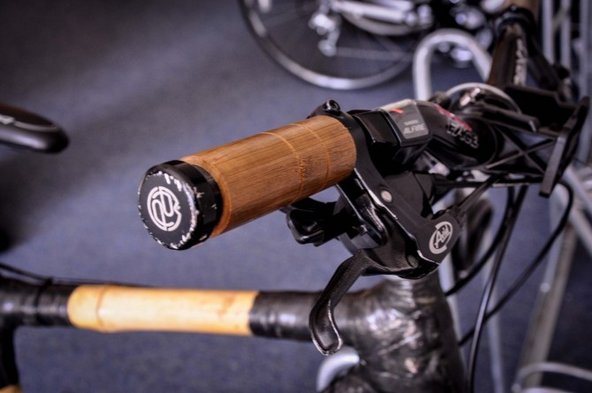In a low, canary yellow warehouse in Kumasi, Ghana, eleven men command a mass of tools—a band saw, grinder, and drill press—to clean and prepare a huge pile of bamboo. What are they making? Bikes: inexpensive, lightweight bikes strong enough to stand up to Kumasi’s long rainy season.
These men are employees of Bamboo Bikes Limited, the Ghana factory of the Bamboo Bike Project, a non-governmental organization dedicated to providing more affordable transportation options in rural Africa and teaching job skills to last a lifetime. It was started by a group of scientists and engineers from The Earth Institute at Columbia University in New York and sponsored by the Millennium Cities Initiative.
Bamboo might seem flimsy (it is a grass, after all), but it’s actually a great bike material. Far from flimsy, it’s stronger than steel—28,000 Newtons of tensile strength per square inch, compared to steel’s 23,000 Newtons. It absorbs shocks, for a reportedly silk-smooth ride. Because it’s hollow, it’s light, too. Bamboo bikes can be made and repaired with fairly simple tools and common materials. (Many people actually cut bamboo using a dozuki, the Japanese pull saw after which we’ve named our work instruction software—the Bamboo Bike Studio’s logo includes a dozuki.)
Bamboo’s also a sustainable material. Unlike trees, which die when cut, bamboo can live on after harvesting. And since decomposing plant material releases carbon dioxide into the atmosphere (over 60 gigatons of it per year), it may actually be better for the environment to harvest bamboo before it dies than let it rot. Plus, bamboo can grow unbelievably quickly under the right conditions. When a bamboo seller charted the growth of some particularly fast-growing shoots, one went from 10 feet to over 22 feet tall in just five days. Bamboo Bike Limited’s bikes are made from bamboo gathered locally in Ghana. Other parts are imported.
Bamboo Bike Limited isn’t the only group making bamboo bikes. A splinter group led by Craig Calfee, BambooSero, broke off in 2008, to start another Ghana factory. They sell Ghana-made bikes worldwide via their website. The Colorado company Panda Bicycles also sells handmade bamboo bikes online.
Or, even better, you can build your own: last week, our product manager, Eric, spotted a woman cutting through the parking lot of our San Luis Obispo office on a bamboo bike. Thinking the bike looked awesome, he flagged her down (no DIY project is safe from our curiosity—at least not in our parking lot!).
Her name is Kathy Reed. She built the bike herself at the San Francisco workshop of the Bamboo Bike Studio, a group started by Bamboo Bike Project volunteers Justin, Marty, and Sean.
The Bamboo Bike Studio sells kits with all the parts and tools you need to build a bamboo bike, including a jig that holds all the bamboo pieces in place as you attach them with resin lugs, then wrap the resin with tape. Following their website’s step-by-step video guides, or going to one of the group’s workshops, you can turn raw plant material into a finished bike in just a single (if rather long and difficult) weekend. Kathy went with her adult son, and they were at the workshop together from 8 a.m. Saturday morning until 9 or ten at night, and then similar hours on Sunday. “It was a lot of work,” Kathy admits. “Parts of it weren’t so fun, like gluing all the parts. But it made me feel really good.”
“They show you how to put on the tires and the braking system, the cables, everything,” she explains. “If you don’t know anything about bikes, you’re not on your own. I just had my son come because he and I share a love for bicycles.”
Kathy does love the bike, and she knows it inside and out. She says, “I’m really attached to the bike because I built it. I constantly am putting tung oil on it to shine it up, and I wipe it down after a ride. I’m really proud of it.” Her familiarity with the bike makes DIY maintenance and repair relatively simple. She has even upgraded it from three speeds to eleven. Kathy was a special education teacher in San Francisco for 38 years, and from when she built the bike in 2010 until she retired this year, she rode the bike to work every day. Now, she goes on a lot of charity rides and runs errands on her bike—she was visiting San Luis Obispo as part of a nostalgia tour, since she is a graduate of our local university, Cal Poly.
Today, a weekend workshop at the Bamboo Bike Studio in Camden, San Francisco, Toronto, or Greensboro costs $1000, and Bamboo Bike Limited’s bikes are sold to Ghana locals for about $65. Bamboo Bike Studio founder Justin Aguinaldo says they are always looking for ways to bring down the cost, and that’s their primary goal going forward. “We’ve made great bikes for a while,” he says. “Now we want to make them with more people for less money.”
The bamboo bike craze is growing—a few enthusiastic Studio customers have set up new studios, and the Studio offers weekend-long workshops in cities around the country. With cheaper bikes and greater availability, maybe some day bamboo bikes will be a common alternative to their carbon-fiber cousins.








0 opmerkingen